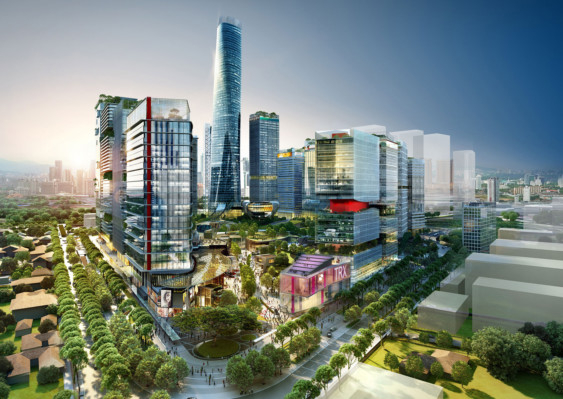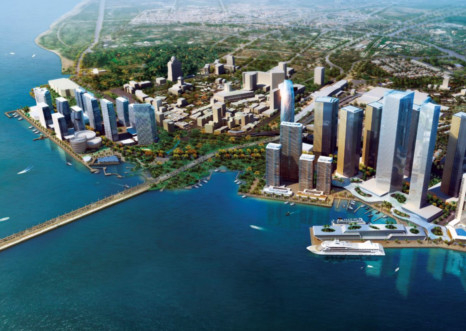
Middle Eastern investment in Malaysia has been traditionally substantial since the country started its push to tap capital and attract tourists from the Middle East under former premier Abdullah Ahmad Badawi in the early 2000s. Since then, the property market in Malaysia has seen strong demand, particularly from the GCC, spanning individual homebuyers and institutional property investors to developers and even sovereign funds.
Global property specialist CBRE estimates that about 10 per cent of the $180 billion (Dh661 billion) to be spent by Middle Eastern buyers on foreign property out of their region in the period up to 2024 will flow into Asia-Pacific. Around $12 billion-$14 billion is estimated to find its way into Malaysia, and some smaller allocations to Indonesia, Singapore, Thailand and Vietnam, as well as Australia — and not for speculation, but as long-term investments.
“The vast majority of Middle Eastern investors are long-term players looking for wealth preservation and strong high-income-producing assets, rather than opportunistic investors playing the cycle for short-term gains,” says Jonathan Hull, managing director of Europe, the Middle East and Africa capital markets at CBRE.
“This strategy favours prime buildings in core markets and often very large lot sizes, and not just residential property but also office and retail,” says Hull. “The diversification benefits that the Asia-Pacific region offers — location-wise and currency-wise — could boost interest from Middle Eastern investors further.”
Mixed-use developments
This makes a case for the various mixed-use projects currently under development in Malaysia, particularly the development of Iskandar, the main southern development corridor in Johor state in the south of peninsular Malaysia at the border with Singapore, and in the Kuala Lumpur capital region with its growing number of mixed-use developments. Among those being developed in Kuala Lumpur include the new Kuala Lumpur International Financial District, comprising office towers for finance and banking, residences and retail spaces in centre of the city, and the KL Gateway south of the city with office towers, residences and shopping facilities. There is also the adjacent Bangsar South, an integrated property development with mid- and high-end condominiums, hotels, restaurants, a health-care centre and commercial spaces.
Another mixed-use development is IOI Resort City, a 138-hectare, self-containing eco city in Putrajaya, the seat of Malaysia’s government located some 24km south of Kuala Lumpur. The development boasts a rich mix of hospitality, retail and leisure services such as a golf course, coupled with future-proof infrastructure and a classy shopping mall.
Elsewhere, on the island of Penang, which is both a popular tourism spot and the heartland of Malaysia’s high-tech industry, Penang Waterfront is being built as an integrated development on the eastern coastline of Penang. It will comprise of premium residential towers, a modern office tower, two international hotels, retail and dining space, as well as the largest convention centre in Penang.
However, Iskandar in the deep south is by far the largest property and economic development zone in Malaysia, covering more than 2,200 sq km of land with mixed-use developments such as Johor Bahru City Centre as a new financial and business district, the waterfront city of Danga Bay, an integrated development in the Tebrau and Plentong districts, the new Johor state administrative centre of Medini Iskandar Malaysia, a medical hub, an education city, heritage parks, a resort for international tourism, an industrial logistic cluster, a free trade zone, a technology cluster and residence districts such as East Ledang, Puteri Harbour, Horizon Hills and Bukit Indah. The zone also features modern infrastructure such as the Malaysia-Singapore causeway, ports and an airport.
Another big urban development is the 246-hectare Melaka Gateway project, an iconic waterfront development on natural and man-made islands off the coast of Malacca City, which will feature premium residential and office buildings, a luxury hotel, an international cruise terminal and a marina, a theme park and the Malaysia Eye Ferris wheel. The entire development is expected to be completed by 2025 at a total investment of more than $12 billion.
“Urban renewal initiatives teamed with land and housing shortages have contributed to a rise in mixed-use real estate investment in Malaysia,” says Sarkunan Subramaniam, managing director of the Malaysia office of Knight Frank. “This goes together with Malaysia’s investment-friendly climate and the fact that the process of buying property itself is quite seamless and quick compared with many other countries.”
Subramaniam, however, notes that whether a foreigner invests in boutique or large-scale developments, legal advice is always recommended. That said, Malaysia is one of the few countries in Asia that allows foreigner to own land as long as it is freehold and not reserved for indigenous Malaysians. Foreigners also have to pay a minimum price of between 400,000 ringgit (Dh344,378) and one million ringgit for each property, depending on the state. In certain districts of the central state of Selangor, foreigners the minimum purchase price for foreigners is two million ringgit.
This indeed opens more options in Malaysia than in other property markets in Southeast Asia.
“The ability to own land not only opens several entirely different classes of investment, such as houses and villas, and the ability to develop, but also different cities and towns,” says Derek Uittenbroek, founder of Malaysia-based property consultancy PropertyLife, adding that this makes a big difference to buying in countries such as Thailand, although Thailand has no minimum price requirements. On the other hand, it is hard to find prime condominium projects outside Bangkok and a few other popular destinations, while in Malaysia, plenty of mid-size cities such as Penang, Kota Kinabalu, Malacca, Johor Bahru, Kuching, Ipoh and Petaling Jaya are popular among expats and retirees alike.
Price
Prices per square metre in Malaysia are still among the lowest in Southeast Asia, so the required minimum investment already buys quite a roomy property. Kuala Lumpur has the highest average price per square meter in Malaysia of around $2,200 for prime property in the city centre, although this is still among the lowest in the region. A $1 million investment would buy a whopping 454-sq-m residential property in Kuala Lumpur, while the same amount would get just 180 sq m in a new prime development in Bangkok, 162 sq m of prime accommodation in Dubai, 71 sq m in Singapore and a tiny 30-sq-m flat in Hong Kong.
Taking into account the current undervaluation of the Malaysian currency of around 46 per cent to the US dollar and dollar-pegged currencies in the GCC, there is a good window of opportunity to purchase property in Malaysia, even as a proposed regulation by Malaysia’s housing ministry will make it mandatory for foreign property buyers to pay in US dollars rather than in ringgit.
Malaysia has one of Southeast Asia’s most well-documented and secure titling systems for both land and residential units. Side costs and fees at around 4-5 per cent are also low compared to other countries in the region, as is the capital gains tax on property. Another advantage is that financing is available for foreigners and there are no restrictions on the transfer of funds to and from other countries.
GCC investors can also use Islamic finance to fund property purchases in Malaysia or use a Sharia-compliant housing payment plan from the developer since there is no shortage of Islamic finance institutions in the country. Adding to that, since Malaysia is a majority Muslim country, culture and customs are broadly aligned with those in the Middle East, which is another positive factor for GCC buyers.
Retirement cities
For those who do not just want to invest but stay in Malaysia, such as retirees, there is the Malaysia My Second Home programme or MM2H. “MM2H is among the best retirement visa schemes in the world,” says Bee Wong, real estate agent at Petaling Jaya-based CDB Properties. The programme combines the benefit of home ownership with a long-term visa scheme, offering a 10-year renewable visa for people who meet age and financial requirements, giving the country an edge over many other retirement destinations in the region. In some states, the MM2H scheme also significantly reduces the minimum purchase price requirement.
Generally, Wong recommends buying in Iskandar since there are many choices and it is close to Singapore.
“For investors, there are interesting options,” says Wong. “They can buy individual units through real estate funds, which have higher returns, or buy blocks at a discount.”
Knight Frank’s Malaysia Commercial Real Estate Investment Sentiment Survey 2017 found that investors are now casting their sights beyond Kuala Lumpur and the Klang Valley and towards Johor, Iskandar, Penang and even Sarawak and Sabah in the eastern part of Malaysia, where real estate prices are below the country’s average.
“Penang and Sabah were voted as the highly attractive regions for hotel and leisure investment, likely because of their strong tourism market,” says Subramaniam.
But Kuala Lumpur remains the most popular property investment destination in Malaysia, he adds, because of ongoing urban transport and other infrastructure developments, with rental yields for offices and commercial space expected to rise this year.
Property specialists are also believe that Malaysian real estate is a safe investment, complimented by a business-friendly and deregulated property market. The large number of reputable property developers, most of which are also publicly listed, are known to deliver on time and on budget, making off-plan purchases less risky.
A vibrant secondary real estate market also makes it easy to buy and sell individual homes, while a strong rental market is driven by a growing population and a well-salaried young urban population.












